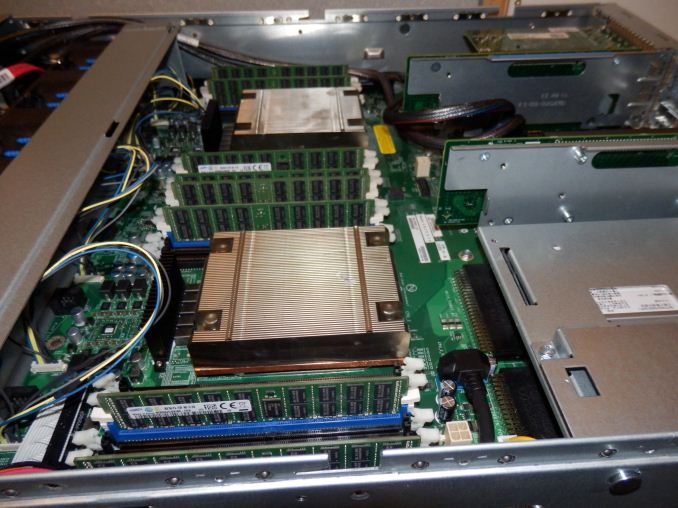Intel Xeon E5 Version 3: Up to 18 Haswell EP Cores
by Johan De Gelas on September 8, 2014 12:30 PM EST
Simply put, the new Intel Xeon "Haswell EP" chips are multi-core behemoths: they support up to eighteen cores (with Hyper-Threading yielding 36 logical cores). Core counts have been increasing for years now, so it is easy to dismiss the new Xeon E5-2600 v3 as "business as usual", but it is definitely not. Piling up cores inside a CPU package is one thing, but getting them to do useful work is a long chain of engineering efforts that starts with hardware intelligence and that ends with making good use of the best software libraries available.
While some sites previously reported that an "unknown source" told them Intel was cooking up a 14-core Haswell EP Xeon chip, and that the next generation 14 nm Xeon E5 "Broadwell" would be an 18-core design, the reality is that Intel has an 18-core Haswell EP design, and we have it for testing. This is yet another example of truth beating fiction.
18 cores and 45MB LLC under that shiny new and larger heatspreader.
The technical challenge of the first step to make sure that such a multi-core monster actually works is the pinnacle of CPU engineering. The biggest challenge is keeping all those cores fed with data. A massive (up to 45MB) L3 cache will help, but with such massive caches, the latency and power consumption can soar quickly. Such high core counts introduce many other problems as well: cache coherency traffic can grow exponentially, one thread can get too far ahead of another, the memory controller can become a bottleneck, and so on. And there is more than the "internal CPU politics".
Servers have evolved into being small datacenters: in a modern virtualized server, some of the storage and network services that used to be handled by external devices are now software inside of virtual machines (VMware vSAN and NSX for example). In other words, not only are these servers the home of many applications, the requirements of these applications are diverging. Some of these applications may hog the Last Level Cache and starve the others, others may impose a heavy toll on the internal I/O. It will be interesting to see how well the extra cores can be turned into real world productivity gains.
The new Xeon E5 is also a challenge to the datacenter manager looking to make new server investments. With 22 new SKUs ranging from a 3.5GHz quad-core model up to an 18-core 2.3GHz SKU, there are almost too many choices. While we don't have all of the SKUs for testing, we do have several of them, so let's dig in and see what Haswell EP has to offer.











85 Comments
View All Comments
coburn_c - Monday, September 8, 2014 - link
MY God - It's full of transistors!Samus - Monday, September 8, 2014 - link
I wish there were socket 1150 Xeon's in this class. If I could replace my quad core with an Octacore...wireframed - Saturday, September 20, 2014 - link
If you can afford an 8-core CPU, I'm sure you can afford a S2011 board - it's like 15% of the price of the CPU, so the cost relative to the rest of the platform is negligible. :)Also, s1150 is dual-channel only. With that many cores, you'll want more bandwidth.
peevee - Wednesday, March 25, 2015 - link
For many, if not most workloads it will be faster to run 4 fast (4GHz) cores on 4 fast memory channels (DDR4-2400+) than 8 slow (2-3GHz) cores on 2 memory channels. Of course, if your workload consists of a lot of trigonometry (sine/cosine etc), or thread worksets completely fit into 2nd level cache (only 256k!), you may benefit from 8/2 config. But if you have one of those, I am eager to hear what it is.tech6 - Monday, September 8, 2014 - link
The 18 core SKU is great news for those trying to increase data center density. It should allow VM hosts with 512Gb+ of memory to operate efficiently even under demanding workloads. Given the new DDR4 memory bandwidth gains I wonder if the 18 core dual socket SKUs will make quad socket servers a niche product?Kevin G - Monday, September 8, 2014 - link
In fairness, quad socket was already a niche market.That and there will be quad socket version of these chips: E5-4600v3's.
wallysb01 - Monday, September 8, 2014 - link
My lord. My thought is that this really shows that v3 isn’t the slouch many thought it would be. An added 2 cores over v2 in the same price range and turbo boosting that appears to functioning a little better, plus the clock for clock improvements and move to DDR4 make for a nice step up when all combined.I’m surprised Intel went with an 18 core monster, but holy S&%T, if they can squeeze it in and make it function, why not.
Samus - Monday, September 8, 2014 - link
I feel for AMD, this just shows how far ahead Intel is :\Thermogenic - Monday, September 8, 2014 - link
Intel isn't just ahead - they've already won.olderkid - Monday, September 8, 2014 - link
AMD saw Intel behind them and they wondered how Intel fell so far back. But really Intel was just lapping them.